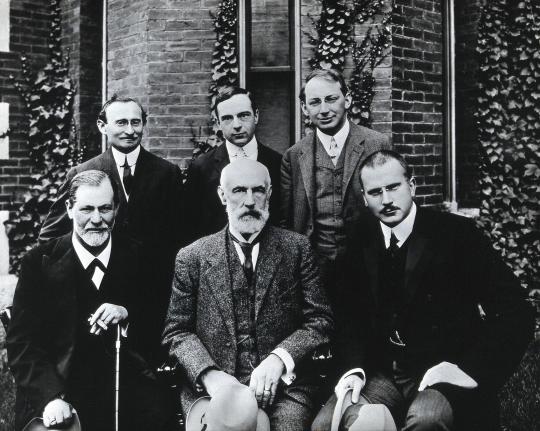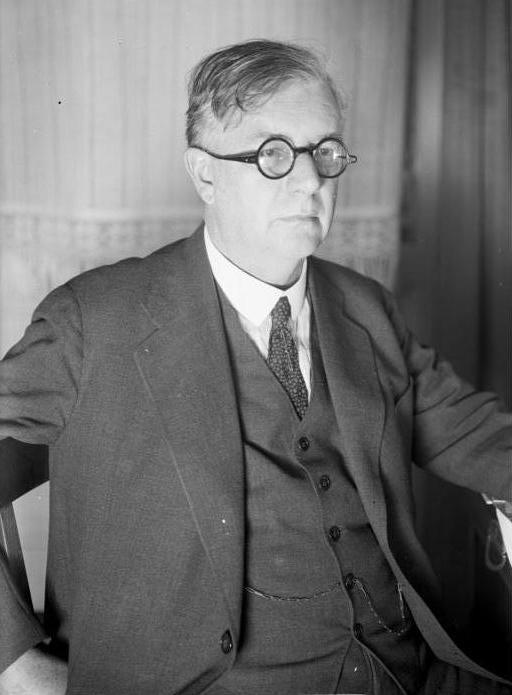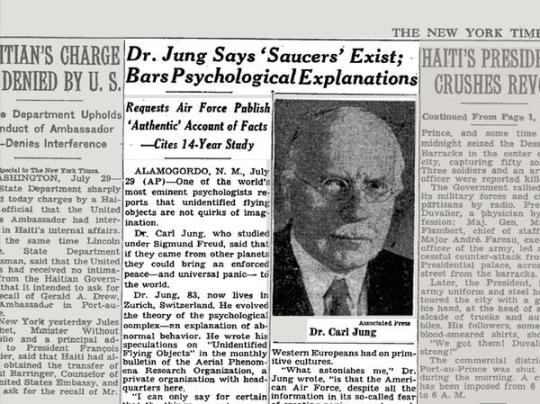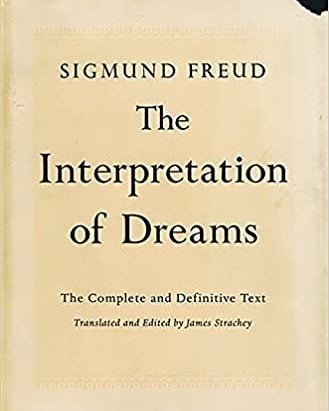#a.a. brill
Explore tagged Tumblr posts
Text

Sigmund Freud - Freud's Interpretation of Dreams - Coles - 1980
#witches#shrinks#occult#vintage#freud's interpretation of dreams#sigmund freud#freud#dreams#interpretation#dreams interpretation#coles books#coles#toronto#rexdale#ontario#authorised translation#third edition#a.a. brill#1980
35 notes
·
View notes
Text




Andrea Dworkin, Mercy / Sigmund Freud, The Interpretation of Dreams, trans. A.A. Brill
66 notes
·
View notes
Text

Os 110 anos da ruptura de Carl Jung com Sigmund Freud e os caminhos que levaram a “Um mito moderno sobre coisas vistas no céu”
“A Idade Média, a Antiguidade e a Pré-História ainda não estão extintas, como muitos ‘esclarecidos’ pensam, mas continuam alegremente vivas, em segmentos significativos da população. As mais antigas mitologias e magias continuam, como sempre, prosperando em nossos meios e só são ignoradas por alguns poucos que se distanciaram do seu estado original, através da sua educação racionalista.” (Carl Gustav Jung in Um mito moderno sobre coisas vistas no céu, Vozes, p.55)
Por Cláudio Tsuyoshi Suenaga
O psiquiatra e psicanalista suíço Carl Gustav Jung (1875-1961), filho de um pastor protestante e de uma mãe afeita ao espiritismo, de 1895 a 1899 praticou experimentos espiritualistas com uma prima materna que costumava cair em transes. Sua dissertação de conclusão do curso de Medicina, sob a orientação deu conterrâneo, o psiquiatra Eugen Bleuler (1857-1939), intitulada Sobre a psicologia e a patologia dos assim chamados fenômenos ocultos, publicada em 1902, versava sobre esses experimentos. Talvez este teria sido o gérmen para o seu interesse pelo Fenômeno OVNI que culminaria, em 1958, apenas três anos antes de sua morte, com o livro Um mito moderno sobre coisas vistas no céu, um marco para a ufologia, bem como para suas especulações místicas e religiosas.
Foi em 1900 que pela primeira vez entrou em contato com a obra de Freud por meio da leitura de A Interpretação dos Sonhos, mas só sete anos depois é que o conheceria pessoalmente. Conversaram animadamente durante nada menos do que treze horas seguidas, ao que se seguiu uma intensa colaboração científica. Juntos, desbravaram os campos inexplorados do inconsciente para estabelecer as primeiras teorias psicológicas a respeito. Freud o considerava seu sucessor, sem saber que Jung ia cada vez mais além e se distanciava em conceitos básicos, como a religião e a sexualidade, mormente no que tangia à teoria da libido.

Sigmund Freud, G. Stanley Hall, C.G. Jung, A.A. Brill, Ernest Jones e Sándor Ferenczi posam para foto na Clark University, Worcester, Massachusetts, em setembro de 1909. Fonte: Library of Congress/Smithsonian.
A inevitável e dolorosa ruptura com o seu “pai adotivo” e pai da psicanálise ocorre em 1912, um ano depois de Jung publicar seu Transformações e símbolos da libido, mais tarde revisada e intitulada Símbolos de transformação, no qual interpreta as fantasias de Miss Miller, uma jovem norte-americana que sofrera um surto psicótico. O conteúdo mitológico das fantasias de Miss Miller acabou servindo de base à teoria de Jung para a existência de um psiquismo impessoal e universal: o inconsciente coletivo, concebido como um repositório de todas as experiências humanas desde as origens. Essas forças inconscientes ou tendências instintivas formariam representações, os arquétipos, “imagens primordiais” que, atinou Jung, existem pré-conscientemente e compõem as “dominantes estruturais” de todos os seres vivos a determinar a sua “índole específica”.
Freud sente-se traído e Jung fica literalmente sem chão e em apuros, vendo conhecidos e amigos o abandonarem. Inicia-se aí o período mais difícil e delicado de sua vida, repleto de incertezas e desorientações que o levaram a abandonar as atividades acadêmicas e partir para uma jornada solitária terrível em busca do autoconhecimento, a um decisivo confronto com o inconsciente que se estenderá por seis anos, durante os quais tudo de essencial lhe seria decidido.
Possuído por imagens profundas e premido por um intenso tumulto interior, sonhos de morte e renascimento o perturbavam. Foi então que pela primeira vez pintaria uma mandala, uma representação circular do cosmos em conexão com os poderes divinos, que Jung reconhece como uma representação do processo psíquico de individuação, regido pelo self, um princípio ordenador central e total, capaz de reintegrar a personalidade.

O isolamento de Jung só seria interrompido quando o sinólogo, teólogo e missionário alemão Richard Wilhelm (1873-1930), tradutor e introdutor no Ocidente do antiquíssimo oráculo chinês I Ching – O Livro das mutações, entregou a Jung um exemplar do manuscrito O Segredo da Flor de Ouro, acompanhado do pedido para que escrevesse um comentário psicológico sobre o texto. Wilhelm, convicto de que Jung mobilizara conceitos que se aproximavam daqueles da sabedoria chinesa, pretendia estabelecer paralelos entre a psicanálise e os ensinamentos do oráculo. Jung passou então a estudar também a tradição alquímica e a sua imagem central, a do opus, que representa a busca sagrada de um valor supremo. Jung via no esforço da individuação a mesma busca dos alquimistas em desvendar o segredo capaz de transformar a matéria grosseira em ouro, ou encontrar a “pedra filosofal”.

Richard Wilhelm

A proposta analítica-terapêutica de Jung, por sua notável abrangência e alcance, se afigura como um desafio pessoal ao autoconhecimento e à autotranscendência, um desvelamento ao profundo mistério da existência, um chamado da jornada interior para o reencontro consigo mesmo e à realização pessoal. O legado de Jung, reunido em 18 volumes, expandiu exponencialmente o conhecimento sobre o homem e a natureza humana, sendo referência na arte, história, religião, mitologia, filosofia, espiritualidade e até na física quântica. Contudo, compreensivelmente, Jung sempre foi considerado um tanto místico por grande parte dos psicólogos, e suas ideias, ainda mal digeridas, são renegadas e relegadas a uma importância secundária nas cátedras acadêmicas.
Um dos conceitos mais notáveis cunhados por Jung, ele que já havia nos legado os de self, individuação, sombra, anima e animus, é o de sincronicidade, acontecimentos que se relacionam por significado e não por causalidade, referendado pela primeira vez em 1929, embora só 21 anos depois concluísse a obra Sincronicidade: um princípio de conexões acausais.
Comuns a todos, tais coincidências, bastante significativas e absolutamente únicas e efêmeras, não podem ser compreendidas dentro do princípio da causalidade, situando-se dentro dos limites da probabilidade, assim como os OVNIs.
OVNIs que, para Jung, eram projeções inconscientes motivados por um intenso anseio coletivo de salvação num momento crucial de desespero, uma compensação pela unilateralidade de nossa era tecnológica de tendência preponderadamente cientificista. As luzes e imagens circulares no céu seriam a mais antiga e acabada representação simbólica do arquétipo da unificação, equilíbrio e totalidade psíquica: o círculo mandálico, evocação do mito do salvador, do próprio Messias.

Os OVNIs como um fenômeno concreto e real
Jung chamou a atenção também para os relatos de sonhos de seus pacientes, nos quais comumente aparecia a costumeira forma lenticular ou de charuto, que aludia à dos primeiros dirigíveis. A interpretação psicanalítica correlacionou a forma de gota dos OVNIs a um símbolo feminino, e a do charuto a um masculino. Os substratos psíquicos arcaicos traduzem o desconhecido ou o incompleto por vias instintivas, o que levou Freud a propor que as formas redondas ou ocas são de cunho feminino, e as longitudinais, masculino. Jung procurava analisar os símbolos oníricos como mecanismos psíquicos regulatórios e até mesmo premonitórios, portadores de mensagens e avisos.
Se as teorias junguianas por si mesmas são insuficientes para explicar o Fenômeno OVNI como um todo, por outro lado alargaram sobremaneira o seu campo epistemológico e o equipararam a um fenômeno religioso e místico, uma das manifestações mais pungentes das profundezas do inconsciente coletivo.
Em seu Um mito moderno sobre coisas vistas no céu, Jung não se restringe, porém, ao caráter metafísico de tais “coisas vistas no céu”, pois reconhece a materialidade e a inteligência atribuída a esses objetos numinosos providos de forças míticas, especialmente quando reportados por testemunhas abalizadas como pilotos, controladores de voo e oficias de alto escalão.
Uma carta escrita por Jung em 1957, posta em leilão pela Swann Auction Galleries no início de 2013, revela que o psicanalista suíço estava pessoalmente interessado no Fenômeno OVNI, e não apenas do ponto de vista profissional. A carta foi encaminhada ao jornal New Republic de Washington e é uma resposta ao pedido de Gilbert Harrison, o editor do jornal, para que escrevesse um artigo sobre os OVNIs a propósito do livro Um mito moderno do próprio Jung, que estava preste a ser lançado.
Dadas as fortes implicações psicológicas do fenômeno na mitologia moderna, Jung lamenta que, “afinal, os OVNIs pareçam reais”.
Em vez de especular sobre sua suposta origem extraterrestre, Jung se pergunta qual o significado desses fenômenos, reais ou imaginários, para a humanidade em um momento como este, quando se sente ameaçado como nunca antes em sua história. De acordo com Jung, os OVNIs devem ser considerados como um fenômeno descrito na forma do “mito moderno”.
Eis a íntegra da carta:
“Caro Sr. Harrison,
O problema dos OVNIs é, como você disse com razão, muito fascinante, mas ao mesmo tempo também é desconcertante, pois, apesar de todas as observações que me são conhecidas, não há certeza sobre sua natureza.
Por outro lado, há um material esmagador que aponta para sua natureza mítica ou mitológica. É um fato que o aspecto psicológico do fenômeno é tão fundamental, que é quase lamentável que os OVNIs pareçam reais, afinal de contas.
Acompanhei o fenômeno o máximo possível e, na verdade, parece que algo foi visto e confirmado também por radares, mas ninguém sabe exatamente o que está vendo.”
Como indicado na carta, embora Jung estivesse interessado principalmente no aspecto psicológico do problema, ele havia feito extensas pesquisas para entender se o fato mitológico era baseado em um evento físico.
A partir de uma revisão dos dados objetivos disponíveis sobre o fenômeno e da análise de seus traços nos sonhos e obras dos artistas, Jung conclui que são imagens unificadoras produzidas pelo inconsciente com uma função de reafirmação diante de um estado de perplexidade coletiva nos anos do pós-guerra.
Mas isso não excluiria a hipótese – apoiada pela teoria da sincronicidade – da percepção de realidades físicas concretas ainda não demonstráveis com instrumentos científicos."

Em 1955, Jung já havia escrito um artigo em uma revista britânica sobre OVNIs, a Flying Saucer Review, na qual afirmava:
“Ao longo dos anos, colecionei uma quantidade considerável de observações, incluindo os relatos de duas testemunhas oculares que eu conhecia pessoalmente. Eu também li sobre o assunto. No entanto, só posso dizer com certeza: estas coisas não são apenas ‘rumores’, algo foi visto.”
Embora Jung admitisse que os OVNIs pudessem ser reais e mostrasse o seu interesse pelo fenômeno dos discos voadores para além de suas implicações psíquicas, o fato de ter usado o termo “mitológico” em seu livro deu força aos céticos para pugnarem pela imaterialidade dos OVNIs.
Para tirar qualquer dúvida, Jung escreveu um relatório que foi distribuído pela Associated Press e impresso em 30 de julho de 1958 no New York Herald Tribune, no qual se lê:
“O Dr. Carl Jung, um psicólogo suíço, diz em um relatório publicado ontem que objetos voadores não identificados são reais e mostram sinais de comando inteligentes, provavelmente por pilotos quase humanos. Segundo o estudioso, o fenômeno é muito mais do que uma simples sugestão.
Uma explicação puramente psicológica é excluída. O Dr. Jung, que iniciou seu estudo sobre OVNIs em 1944, divulgou sua declaração através do Centro de Filtragem de OVNIs da Organização de Pesquisa sobre os Fenômenos Aéreos [Aerial Phenomena Research Organization (APRO)], fundada em Tucson, no Arizona, pelo casal Jim e Coral Lorenzen em 1952.”

#carl gustav jung#sigmund freud#sincronicidades#psicologia#inconsciente#ufologia#discos voadores#fenomeno ufo#fenomeno ovni#mandala#individuation#misticismo#esoterismo#alquimia
8 notes
·
View notes
Text
In 1928 a young public relations man from New York named Edward Bernays was hired by the American Tobacco Company to promote smoking among American women. His first campaign focused on women’s anxieties about weight. On Bernays’ advice the company used the suggestion “Reach for a Lucky Instead of a Sweet” in its advertising, and sales of Lucky Strike cigarettes soared.
The tobacco company, however, was not satisfied. Women were smoking in their homes, but they would not smoke in public. The company approached Bernays again and asked him to find a way to get women to smoke on the street. Bernays consulted the well-known psychoanalyst Dr. A.A. Brill who advised him that the emancipation of women had blurred the distinction between male and female roles. Women were doing the same work as men. Those who married had fewer children. Women wanted to do what men did. “Cigarettes,” Brill concluded, “which are equated with men, become torches of freedom.”
What Bernays learned from Brill was that social contagion is not necessarily rational or conscious as sociologist David Phillips later noted in a study of suicide. Phillips made a list of stories about suicide that appeared in the nation’s top newspapers from the end of the 1940s to the end of the 1960s. He compared them to suicide statistics for the same period and found that suicides increased after stories about suicide appeared in the news.
In a bizarre example that the author remembers from the period, radio stations in the San Francisco area began to publicize suicide jumps from the Golden Gate Bridge as the total number of such attempts began to approach 200. They stopped the practice when it became clear that their broadcasts were actually pushing some disturbed individuals into taking the plunge.
Phillips argues that the decision by someone famous to commit suicide has the same effect. “It gives,” he says, “other people, particularly those vulnerable to suggestion because of immaturity or mental illness, permission to engage in a deviant act as well.”
Bernays was captivated by the phrase “torches of freedom,” and he immediately turned it into a public relations campaign. He sent invitations signed by his female secretary to 30 debutantes, inviting them to join her in combating prejudice and sexual stereotypes, by lighting “torches of freedom” during the 1929 Easter Parade on New York’s fashionable Fifth Avenue. Bernays had a photographer ready to photograph several well dressed women lighting up as they left St. Patrick’s Cathedral, and the photos appeared the next day in the major newspapers.
The campaign was a huge success. American women began to smoke in large numbers. By the 1950s more than one-third of American women smoked cigarettes. Echoes of Bernay’s slogan could be heard decades later when another brand of cigarettes advertised that women who smoked that brand had “come a long way baby.”
-- Kenneth Graham, Media Hypnosis in Advertising and Politics
14 notes
·
View notes
Photo

📚 Buy The Interpretation Of Dreams by Sigmund Freud from #boikhata . To order, visit : https://www.boikhata.com.bd/product/the-interpretation-of-dreams/ Sigmund Freud’s audacious masterpiece, ‘The Interpretation of Dreams’, has never ceased to stimulate controversy since its publication in 1900. Freud is acknowledged as the founder of psychoanalysis, the key to unlocking the human mind, a task which has become essential to man’s survival in the twentieth century, as science and technology have rushed ahead of our ability to cope with their consequences. Freud saw that man is at war with himself and often unable to tolerate too much reality. He propounded the theory that dreams are the contraband representations of the beast within man, smuggled into awareness during sleep. In Freudian interpretation, the analysis of dreams is the key to unlocking the secrets of the unconscious mind. Translated by A.A. Brill With an Introduction by Stephen Wilson. AUTHOR: Sigismund Freud (1856 – 1939), better known as Sigmund Freud, was an Austrian psychiatrist who founded the psychoanalytic school of psychology. If some of his ideas, always controversial, have now fallen out of favour, it does not diminish the impact that his thinking has had on psychology, therapy and, indeed, culture in general. His favourite book, ‘The Interpretation of Dreams’, remains the most significant work on the subject matter, even if some of the underlying theories have been discredited. https://www.instagram.com/p/CEh_37Ojoij/?igshid=neq53fv4mpbe
0 notes
Photo

Five Stars Perfect for those interested in the genius interpretations of psychology. Great addition to any collection of classics. Go to Amazon
A classic. Sometimes Freud is just... ... A classic. Sometimes Freud is just... Freud! Go to Amazon
Four Stars It is what it says it is! Go to Amazon
Five Stars Worth reading Go to Amazon
A Good Introduction and Reference The Brill translation of the basic early writings of Sigmund Freud, although arguably not the most accurate translation, provides a good introduction to Freud's early work. We can read the critics and followers, yet sometimes we just have to go back to Freud's actual work. I keep my copy handy for reference and review. Go to Amazon
Five Stars Great Edition Go to Amazon
This book is for Freudians only. It is interesting ... This book is for Freudians only. It is interesting to see how Freud thought and how he approached psychological conditions. He dared to think differently. I have it handy in my bookshelf for quick reviews. Recommendable. Go to Amazon
Good Intro to Freud's Writings As someone with an interest in psychology purely as a hobby, I found this compilation a great start to tapping into Freud's musings. The book has an old-school feel to it, as the type-face looks typewriter-like and the book's hard cover looks like a remnant from earlier days. The font is rather small, but the writing is great, and has challenged a psychological newbie such as myself. The translation appears very good, as everything is clearly worded, while truly carrying a personal tone. Go to Amazon
No Freudian Slip here the grand old man Five Stars Five Stars Must read for psychology fans! Wonderful book about the works of Freud Father of Psychoanalysis
0 notes
Quote
"A classic example of commercialized feminism was a 1929 campaign in which the American Tobacco Company attempted 'to induce women to smoke [cigarettes] in public places.' George W. Hill, owner of American Tobacco had contracted Edward Bernays to run the campaign, hoping to expunge the "hussy" label from women who smoked publicly. The smoking taboo among women, Bernays reasoned, was of deep psychological significance. Accordingly, he consulted the psychoanalyst, A.A. Brill, for advice. Brill's explanation was this: "Some women regard cigarettes as symbols of freedom....Smoking is a sublimation of oral eroticism; holding a cigarette in the mouth excites the oral zone. It is perfectly normal for women to want to smoke cigarettes. Further the first women who smoked probably had an excess of masculine components and adopted the habit as a masculine act. But today the emancipation of women has suppressed many of the feminine desires. More women now do the same work men do....Cigarettes, which are equated with men, become torches of freedom.""
Captains Of Consciousness: Advertising And The Social Roots Of The Consumer Culture
#this was in my on this day on fb so i thought i'd share#i had to read it for my pop culture since 1920 class years ago#feminism
3 notes
·
View notes
Text
Clinical Evaluations in Boynton Beach, FL - Freedom Now Clinic
Table of ContentsWhat Is Clinical And Radiographic DiagnosisHow Is The Clinical Diagnosis Of A Uti EstablishedWhat Is Diagnosis In Clinical PsychologyDual Diagnosis Is A Clinical Diagnosis That Is Used When A Person Is Addicted To More Than One DrugWhat Type Of Results Are To Be Expected Based On A Diagnosis Confirming Clinical Data?What Is The Clinical Diagnosis Of AlchoholsmWhich Of The Following Pairs Must Be Present For The Clinical Diagnosis Of Pps?What Clinical Diagnosis Would You Utilize In ShinglesWhat Does Clinical Diagnosis MeanHow To Write Clinical Diagnosis
Hippocrates was known to make medical diagnoses by tasting his clients' urine and smelling their sweat. Medical medical diagnosis or the actual procedure of making a diagnosis is a cognitive process. A clinician utilizes a number of sources of data and puts the pieces of the puzzle together to make a diagnostic impression. The preliminary diagnostic impression can be a broad term explaining a classification of diseases instead of a specific illness or condition.
Diagnostic procedures are the specific tools that the clinicians utilize to narrow the diagnostic possibilities. The plural of medical diagnosis is diagnoses. The verb is to identify, and a person who diagnoses is called a diagnostician. The word is derived through Latin from the Greek word (dignsis) from (diagignskein), suggesting "to discern, identify".
How To Write Clinical Diagnosis For Dsm 5 And Icd 10
It might be a matter of calling the illness, lesion, dysfunction or impairment. It may be a management-naming or prognosis-naming exercise. It might indicate either degree of problem on a continuum or type of irregularity in a category. It's affected by non-medical aspects such as power, ethics and monetary rewards for client or doctor.
It may be a method of communication such as a computer system code through which it triggers payment, prescription, notification, information or advice. It may be pathogenic or salutogenic. It's normally unpredictable and provisional. When a diagnostic viewpoint has been reached, the service provider has the ability to propose a management strategy, which will include treatment in addition to plans for follow-up.
Which Of The Following Is A Problem With Using Unstructured Clinical Interviews In Diagnosis?
A treatment strategy is proposed which might include therapy and follow-up consultations and tests to keep track of the condition and the progress of the treatment, if required, usually according to the medical guidelines provided by the medical field on the treatment of the particular illness. what clinical assessment data supports the diagnosis of arf for mrs. hayes. Pertinent info should be contributed to the medical record of the patient.
Nancy McWilliams identifies 5 factors that determine the requirement for medical diagnosis: diagnosis for treatment planning; info included in it related to prognosis; protecting interests of patients; a medical diagnosis may help the therapist to empathize with his client; might decrease the probability that some afraid clients will go-by the treatment. Sub-types of medical diagnoses consist of: Scientific medical diagnosis A medical diagnosis made on the basis of medical indications and reported signs, instead of diagnostic tests Laboratory medical diagnosis A diagnosis based considerably on lab reports or test results, instead of the physical exam of the client.
What Is A Clinical Diagnosis
Radiology diagnosis A diagnosis based mainly on the results from medical imaging studies. Greenstick fractures prevail radiological diagnoses. Tissue medical diagnosis A diagnosis based upon the macroscopic, microscopic, and molecular assessment of tissues such as biopsies or entire organs. For instance, a conclusive medical diagnosis of cancer is made through tissue examination by a pathologist.
Many clients have extra diagnoses. Admitting diagnosis The diagnosis given as the reason the patient was confessed to the health center; it may vary from the actual issue or from the discharge diagnoses, which are the medical diagnoses taped when the client is discharged from the health center. A procedure of determining all of the possible diagnoses that might be connected to the signs, symptoms, and laboratory findings, and then ruling out medical diagnoses up until a last decision can be made.
What Is The Definition Of Clinical Diagnosis
They are standards, usually released by worldwide committees, and they are developed to provide the very best sensitivity and uniqueness possible, respect the existence of a condition, with the advanced technology. Medical diagnosis work done before birth A medical condition whose presence can not be developed with total self-confidence from history, examination or screening.
The medical diagnosis of two related, however different, medical conditions or co-morbidities. The term often described a diagnosis of a severe mental illness and a compound dependency, nevertheless, the increasing occurrence of hereditary testing has actually revealed lots of cases of patients with several concomitant congenital diseases. The medical diagnosis or recognition of a medical conditions in oneself.
How Does A Clinical Psychologist Diagnosis
What Is A Clinical Diagnosis
A type of telemedicine that diagnoses a client without being physically in the same space as the patient. Rather than focusing on biological procedures, a nursing diagnosis recognizes individuals's reactions to situations in their lives, such as a preparedness to alter or a determination to accept assistance. Supplying signs enables the computer system to recognize the issue and detect the user to the very best of its ability.
The medical diagnosis of "illness" that will never ever trigger symptoms, distress, or death throughout a client's lifetime An unclear, or even completely phony, medical or psychiatric label offered to the patient or to the medical records department for essentially non-medical reasons, such as to assure the client by supplying an official-sounding label, to make the supplier appearance efficient, or to obtain approval for treatment.
What Is A Clinical Diagnosis
The labeling of a disease in a historic figure or particular historic occasion utilizing contemporary knowledge, approaches and disease categories. See for variants. Thompson, C. & Dowding, C. (2009) Essential Decision Making and Medical Judgement for Nurses. "Making a medical diagnosis", John P. Langlois, Chapter 10 in Principles of clinical practice (2002 ).
Mengel, Warren Lee Holleman, Scott A - what is clinical diagnosis. Fields. Second edition. p. 198. "Making a diagnosis", John P. Langlois, Chapter 10 in Fundamentals of medical practice (2002 ). Mark B. Mengel, Warren Lee Holleman, Scott A. Fields. 2nd edition. p. 204. Wadhwa, R. R.; Park, D. Y.; Natowicz, M. R. (2018 ). "The precision of computerbased diagnostic tools for the recognition of concurrent congenital diseases".
Which Clinical Manifestations Support A Diagnosis Of Hyperglycemia? Select All That Apply.
176 (12 ): 270409. doi:10.1002/ ajmg.a. 40651. PMID 30475443. Decision support group. 26 July 2005. 17 Feb. 2009 "workup". The Free Dictionary. Damestani , Yasaman( 2013 ). "Transparent nanocrystalline yttria-stabilized-zirconia calvarium prosthesis". Nanomedicine. Elsevier Inc. 9( 8): 113538. doi:10.1016/ j.nano. 2013.08.002. PMID 23969102. Discussed by Mohan, Geoffrey( September 4, 2013). "A window to the brain? It's here, states UC Riverside team". "Diagnostic errors are leading cause of effective.
malpractice claims ". The Washington Post. 2012-04-30. Obtained 2016-10-31. "What is overdiagnosis?". NCBI. Coon, Eric; Moyer , Virginia; Schroeder, Alan; Quinonez, Ricardo." Overdiagnosis: How Our Obsession for Diagnosis May Be Harming Kid". AAP News and Journals Gateway. Gawande, Atul." America's Upsurge of Unnecessary Care ". The New Yorker. Improving Diagnosis in Health Care. Washington, DC: The National Academies Press. p. S-1. doi:10.17226/ 21794. ISBN 978-0-309-37769-0. PMID 26803862. CS1 maint: multiple names: authors list( link) Johnson, P. E. ; Duran, A. S.; Hassebrock, F.; Moller, J.; Prietula, M.; Feltovich, P. J.; Swanson, D. B.( 1981). "Expertise and Mistake in Diagnostic Reasoning". Cognitive Science. doi:10.1207/ s15516709cog0503_3. Chan, K. W.; Felson, D. T.; Yood, R. A.; Walker, A. M. (1994).
How Does A Clinical Psychologist Diagnosis
" The lag time between onset of signs and medical diagnosis of rheumatoid arthritis ". Arthritis and Rheumatism. 37 (6 ): 81420. doi:10.1002/ art. 1780370606. PMID 8003053. Workplace of Health and Human Solutions: Workplace of Inspector General (1993 ). " Medicare's Reimbursement for Interpretations of Medical Facility Emergency Clinic X-Rays "( PDF)." Edwin Smith Papyrus". Retrieved 2015-02-28. H. F. J. Horstmanshoff, Marten Stol, Cornelis Tilburg( 2004), Magic and Rationality in Ancient Near Eastern and Graeco-Roman.
Medicine, pp. 9798, Brill Publishers, 90-04-13666-5. Jingfeng, C.( 2008 )." Medication in China". Encyclopaedia of the History of Science, Technology, and Medicine in Non-Western Cultures. pp. 152934. doi:10.1007/ 978-1-4020-4425-0_8500. "What Would Hipocrates Do?". Retrieved February 28, 2015." Online Etymology Dictionary". Treasure, Wilfrid (2011). " Chapter1: Medical diagnosis". Diagnosis and Threat Management in Medical care: words that count, numbers that speak. Oxford: Radcliffe. ISBN 978-1-84619-477-1. McWilliams, Nancy( 2011). Psychoanalytic Diagnosis. Guilford. p. 8. ISBN 978-1-60918-494-0." confessing medical diagnosis". The Free Dictionary . Berner, E. D.; Shugerman, A.A.; et al." Performance of 4 computer-based diagnostic systems". New England Journal of Medication. 330( 25): 179296. doi:10.1056/ NEJM199406233302506.
Where Can I Get Clinical Cases And Diagnosis
youtube
youtube
WebMed Solutions. "Connection between start of signs and medical diagnosis". Archived from the original on 13 February 2019. Recovered 15 January 2012. It's especially essential to talk to a GP if you: In some cases, when you're depressed it can be difficult to picture that treatment can really assist. But the quicker you look for treatment, the sooner your anxiety will enhance (describe the goals of clinical assessment and diagnosis. explain how these goals affect treatment.). There are no physical tests for depression, but a GP may examine you and perform some urine or blood tests to eliminate other conditions that have comparable symptoms, such as an underactive thyroid. Try to be as open and truthful as you can be with your responses. Describing your signs and how they're affecting you will assist the GP figure out whether you have anxiety and how serious it is . Any conversation you have with.
a GP will be confidential. This rule will just ever be broken if there's a considerable danger of harm to either yourself or others, and if notifying a member of the family or carer would reduce that danger.
Freedom Now Clinic
236 SE 23rd Ave, Boynton Beach, FL 33435
GW4P+R9 Boynton Beach, Florida
https://myfreedomnow.com/
https://myfreedomnow.com/medical-clinical-evaluations/
Clinical Evaluations in Boynton Beach, FL
Find Freedom Now on Google Maps!
Videos:
https://youtu.be/dkSw1tLNN78
https://vimeo.com/451581551
Further Information:
https://freedomnowclinic.blogspot.com/2020/08/clinical-evaluations-in-boynton-beach.html
from Freedom Now Clinic https://freedomnowclinic.blogspot.com/2020/08/clinical-evaluations-in-boynton-beach.html
0 notes
Text
DENIAL (n.)
1520s, «refusal to grant what is requested or desired;» see deny + -al (2). Replaced earlier denyance (late 15c.). Sense of «act of asserting to the contrary, contradicting» is from 1570s; that of «refusal to accept or acknowledge» is from 1580s. In some 19c. uses, it really means «self-denial.» Meaning «unconscious suppression of painful or embarrassing feelings» first attested 1914 in A.A. Brill’s translation of Freud’s «Psychopathology of Everyday Life»; hence the phrase in denial, popularized 1980s.
0 notes
Text
But that uptick in sales wasn’t enough. In 1928, Hill hired Edward Bernays, often called the “father of public relations,” to transform the popular perception of women who smoked. Bernays turned to psychoanalyst A.A. Brill, who supplied him with what may have been the best pull quote of all time: “Today,” Brill wrote, “the emancipation of women has suppressed many of their feminine desires. More women now do the same work as men do. Many women bear no children; those who do bear have fewer children. Feminine traits are masked. Cigarettes, which are equated with men, become torches of freedom.”
Berneys took the phrase and ran with it, paying women to smoke while marching in the Easter Sunday Parade of 1929, hiring his own photographers to capture them doing it, and publishing the photos around the world. In another PR coup, feminist Ruth Hale took up the chant, saying, “Women! Light another torch of freedom! Fight another sex taboo!” That year, the percentage of cigarettes sold to women in the U.S. rose to 12 percent; by 1935 it was at 18 percent; it continued to rise until it plateaued from 1965-1977 when women made up a full third of the smoking market.
Lorraine Greaves writes, “The cultural meaning of women’s smoking … is shifting from being a symbol of being bought by men (prostitute), to being like men (lesbian/mannish), to being able to attract men (glamorous/heterosexual). To this could also be added its symbolic value of being equal to men (feminism) and being your own woman (emancipation). However, despite this proliferation in messages and meanings, it is striking how tobacco companies have continued to use imagery around emancipation, the cigarette as a “torch for freedom,” as they attempt to develop new markets among women around the world.”
Marya Hornbacher, Why Do We Smoke?
0 notes